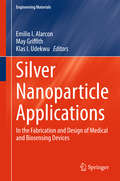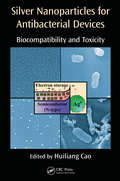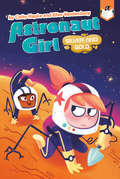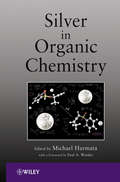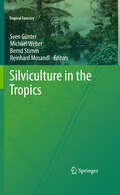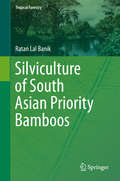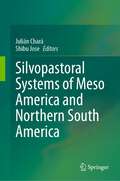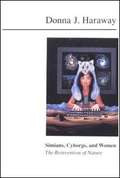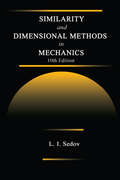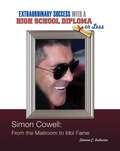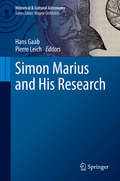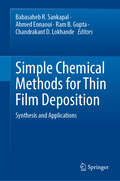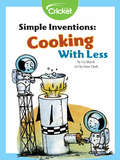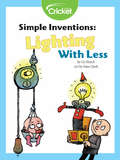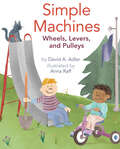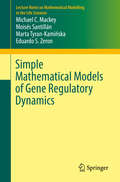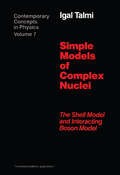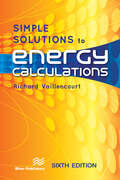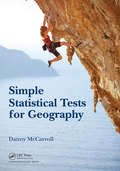- Table View
- List View
Silver Nanoparticle Applications
by Emilio I. Alarcon May Griffith Klas I. UdekwuExploring the synthesis, characterization, surface manipulation, electron transfer and biological activity of silver nanoparticles, this book examines the fundamentals of the properties and synthesis of these particles. With a renewed interest in silver nanoparticles, this book addresses the need to understand their potential in industrial, medical and other applications. It is divided into six chapters, each written by an expert and providing a comprehensive review of the topic while detailing recent advances made in each specific area. These topics include surface plasmon band, synthesis and characterization, Surface-enhanced Raman spectroscopy (SERS) and plasmon resonance mediated processes, photocatalysis, biomedical applications and biological activity. It also presents the current state of the art, challenges and future trends of catalysis, sensing and biomedical applications. 'Silver Nanoparticle Applications' provides an invaluable reference work and introduction for chemists, biologists, physicists and biomedical researchers who are interested in exploring the uses and applications of silver nanoparticles. It is also intended for students, researchers and professionals interested in nanotechnology.
Silver Nanoparticles for Antibacterial Devices: Biocompatibility and Toxicity
by Huiliang CaoSince the potential toxicity of silver nanoparticles (Ag NPs) has raised serious concerns in the biomaterials and biomedical engineering community, Silver Nanoparticles for Antibacterial Devices: Biocompatibility and Toxicity brings together the synthesis, the physicochemical properties and the biological actions of Ag NPs, as well as the clinical demands for fabricating antibacterial medical devices, discussing how to suppress the side effects of nanomaterials and how to impart to them the selective toxicity. This book presents the two primary paradigms that have emerged in probing the antibacterial applications of Ag NPs, i.e. the active attacking releasing way and the conservative defending approach by taking advantage of various short-range actions; it shows readers how the ways in which Ag NPs have behaved can be engineered purposively. With contributions from leading international experts and extensive references listed in each chapter, this volume provides the general principles on controlling the physicochemical behaviors of nanomaterials and managing their toxicity risks.
Silver and Gold #3 (Astronaut Girl #3)
by Cathy Hapka Ellen VandenbergCan Astronaut Girl save the day with a little help from science? Find out as she and her space crew blast off on new adventures in this chapter book series!Val and Wallace aren't looking forward to the last weekend of summer vacation, though they are excited about going to the local town fair! But after Wallace's friend Carlos shows up for a visit, the day quickly goes downhill for Val. Things get even worse when Astronaut Girl, Wallace, the Astro crew, and Carlos end up in a spaceship zigzagging through an asteroid belt! Can Val and Carlos put their differences aside to get them all safely back home?Exciting, easy-to-read books are the stepping stone a young reader needs to bridge the gap between being a beginner and being fluent.
Silver in Organic Chemistry
by Michael HarmataThe first authoritative book on using silver cations in organic chemistry—for catalysis and more! With more sophisticated catalytic methodologies fueling a resurgence in the study of cation-based chemistry, gold and platinum have stepped to the fore as the unique agents used to create new chemical reactions. Although these metals have become a primary focus of researchers in the field, another coinage metal that is often overlooked—but is as powerful as the others—is silver, a far less costly alternative to gold and platinum in aiding the development of new reactions. Making a strong case for the use of silver as a catalyst and structural element in organometal constructs, this authoritative book is the first to explore the benefits of using silver in organic chemistry by taking a close look at silver’s unique reactivity and structural characteristics for the development of new methods and materials. Silver in Organic Chemistry is: The first book to address catalysis using silver, whose use in organic chemistry is on the verge of exploding A resource for researchers wishing to do chemistry with silver cations, an area that stands in the shadow of gold chemistry, but still glistens, demonstrating that all that glitters is not gold—sometimes it’s silver! A guide for “first attempts” in working with silver cations Edited by a very well-respected, highly visible authority in this field Silver in Organic Chemistry promotes further scientific discussion by offering important new ways to examine the future possibilities of an emerging field. By elevating the importance of silver chemistry, this thought-provoking guide illustrates how this versatile metal can become an increasingly significant player in opening the door to new catalytic organic reactions and new organometal materials.
Silver, Burdett And Ginn Earth Science
by Silver Burdett Ginn ReligionAn interesting book on the science of our world.
Silviculture in the Tropics
by Michael Weber Bernd Stimm Reinhard Mosandl Sven GünterThis book integrates the latest global developments in forestry science and practice and their relevance for the sustainable management of tropical forests. The influence of social dimensions on the development of silvicultural concepts is another spotlight. Ecology and silvicultural options form all tropical continents, and forest formations from dry to moist forests and from lowland to mountain forests are covered. Review chapters which guide readers through this complex subject integrate numerous illustrative and quantitative case studies by experts from all over the world. On the basis of a cross-sectional evaluation of the case studies presented, the authors put forward possible silvicultural contributions towards sustainability in a changing world. The book is addressed to a broad readership from forestry and environmental disciplines.
Silviculture of South Asian Priority Bamboos
by Ratan Lal BanikThis monographaims at bringing out a comprehensive collection of information on bamboovarieties in South Asia. The main focus of this book is to address theecological and economic significance of bamboos. Bamboo is a versatile group of plants, capable of providing ecological,economic and livelihood security to the people. In the tropics, especially therural areas in different countries of South Asia, most of the houses aremade of bamboos. In the hilly areas of Bangladesh, Bhutan, Nepal and India, thetribal people take bamboo shoots as one of their major food items sinceprehistoric days. With palatableshoots and grass like leaves bamboo plants have also been liked by many herbivore animals, such as, elephants,the wild cattle, Indian Bison, and some speciesof deer. The red-panda in the Himalayas, and primates,pigs, rats and mice, porcupines, and squirrels are also incidental feeders onsoutheast Asian bamboos. There has been a growing awareness in recent years about the values ofbamboo being an important means of economic growth and for improving thesocio-economic conditions of the rural poor. Bamboo as an industrialmaterial can substitute wood and that to at low cost. Due to increasing demandand squeezing of bamboo area the plants have been overexploited and the qualityand quantity of resource alarmingly getting depleted. Besides many new bamboobased industries have come up which also urgently require uninterrupted supplyof species wise bamboo resource. The south Asia region has bestowed with more than 300 bamboospecies with enormous diversities at species, ecological and geneticallevel. A number of bamboo species are found common among countriesof the region selected for various utilization potentials having wide range of ability to adjustenvironmental conditions of these countries and thus prioritized forcultivation. Both government and private planters in the region have started allocating funds, land andother logistics to raise large scale plantation of desired bamboospecies. This book has been drafted to find out answers of the most pertinentqueries based on the field observations on each of the bamboo species andknowledge learnt from the indigenous people living with bamboos in differentparts of south-east and south Asian countries. This monograph would beinteresting and useful to bamboo professionals, foresters, horticulturists,field level extension workers, nurserymen, planters, industrial entrepreneurs,ecologists, and valuable source of reference to the relevant researchers andstudents in the region.
Silvopastoral systems of Meso America and Northern South America
by Shibu Jose Julián CharáThis book offers an overview of the most important research and developments in silvopastoral systems of the northern part of South America and Central America, including the most common silvopastoral arrangements in each country and their characteristics in terms of productivity, and environmental and socioeconomic aspects. Featuring a compilation of original research articles, country overviews and reviews of the contribution of silvopastoral systems to different topics, it summarizes the state-of-the-art knowledge regarding various aspects of silvopastoral systems in this region.
Simians, Cyborgs, and Women: The Reinvention of Nature
by Donna J. HarawayA collection of ten essays written mostly during the eighties. With a feminist perspective and the premise that nature is constructed, rather than discovered-- and that truth is made, not found-- Haraway provides an analysis of the popular and scientific struggles involved in the telling of evolutionary tales. The author is a historian of science at the U. of California, Santa Cruz.
Similarity and Dimensional Methods in Mechanics
by L. I. SedovSimiliarity and Dimensional Methods in Mechanics, 10th Edition is an English language translation of this classic volume examining the general theory of dimensions of physical quantities, the theory of mechanical and physical similarity, and the theory of modeling. Several examples illustrate the use of the theories of similarity and dimensions for establishing fundamental mechanical regularities in aviation, explosions, and astrophysics, as well as in the hydrodynamics of ships. Other interesting areas covered include the general theory of automodel motions of continuum media, the theory of propagation of explosion waves in gases, the theory of one-dimensional nonestablished motion in gases, the fundamentals of the gas-dynamics theory of atom-bomb explosion in the atmosphere and the theory of averaging of gaseous flows in channels. Aspects of modeling include the dimensionless characteristics of compressor operation, the theories of engine thrust, and efficiency of an ideal propeller for subsonic and supersonic speeds. Similiarity and Dimensional Methods in Mechanics, 10th Edition is an ideal volume for researchers and students involved in physics and mechanics.
Simon Cowell: From the Mailroom to Idol Fame (Extraordinary Success with a High School)
by Shaina C. IndovinoIn the last few decades, more and more people are going to college to further their education. It's hard to become a scientist, a professor, or a businessperson without getting some sort of college degree--but college isn't always necessary to achieve success. Some people are ready to enter the workforce right after high school. Simon Cowell was one of those people. The son of a British music executive, Cowell--instead of asking for help from his father--worked his way up through the music industry, starting from the mailroom. Though Simon found huge success in the music business, today the sarcastic star is most famous for his part in television shows like "American Idol", "America's Got Talent", and "The X Factor". Simon's known on screen as a short-tempered, sharp-tongued judge, but he's also had a role to play behind the scenes, creating and producing television shows in the United States and Britain. And what's most amazing about his story is that the music and television mogul has done it all without a college degree!
Simon Marius and His Research (Historical & Cultural Astronomy)
by Hans Gaab Pierre LeichThe margravial court astronomer Simon Marius, was involved in all of the new observations made with the recently invented telescope in the early part of the seventeenth century. He also discovered the Moons of Jupiter in January 1610, but lost the priority dispute with Galileo Galilei, because he missed to publish his findings in a timely manner.The history of astronomy neglected Marius for a long time, finding only the apologists for the Copernican system worthy of attention. In contrast the papers presented on the occasion of the Simon Marius Anniversary Conference 2014, and collected in this volume, demonstrate that it is just this struggle to find the correct astronomical system that makes him particularly interesting. His research into comets, sunspots, the Moons of Jupiter and the phases of Venus led him to abandon the Ptolemaic system and adopt the Tychonic one. He could not take the final step to heliocentricity but his rejection was based on empirical arguments of his time.This volume presents a translation of the main work of Marius and shows the current state of historical research on Marius.
Simple Chemical Methods for Thin Film Deposition: Synthesis and Applications
by Ram B. Gupta Chandrakant D. Lokhande Babasaheb R. Sankapal Ahmed EnnaouiThis book explores chemical methods for thin film deposition with diverse nanostructured morphology and their applications. Unlike top-down techniques, chemical methods offer low cost, simplicity, and growth of nanostructured surface architecture with ease of small to large-scale area deposition. The book primarily focuses on innovative twelve chemical methods for thin-film deposition on one platform. Since each method has its own advantages and disadvantages, it is crucial to select the specific method for specific material to be deposited depending upon what type of application is targeted. Due to inclusive of diverse chemical deposition methods, researcher will have knowledge about best choice of the deposition method to be adopted. Inclusive methods discussed in the book are chemical bath deposition, successive ionic layer adsorption and reaction, ion exchange, electroless deposition, electrodeposition, hydrothermal, spray pyrolysis, spin coating, dip coating, doctor blade, screen printing, and sol-gel.The selection of the correct procedure for material to be deposited in thin film form depends on its unique process parameters based on the kind of application and its requirement. The role of preparative factors necessary for thin film alters properties related to structure and surface morphology, electrical conductivity and optical band gap which have been extensively discussed along with the underlying science of film synthesis. The book provides a comprehensive overview of the field of chemical methods for thin film synthesis to applications. In addition to synthesis, the book covers characterization, instrumentation, and industrial application of thin films. As a result, concentrated techniques will be of great interest to university/college professors, students and new engineers as well as postdocs and scientists in the area.
Simple Inventions: Cooking with Less
by Liz HuyckCooking over a wood fire can burn a lot of fuel. How can we reduce the amount of fuel we use?
Simple Inventions: Lighting with Less
by Liz HuyckNot everyone can afford a power plant to produce their electricity. Here are some simple solutions to light up your life with less!
Simple Machines (Let's-Read-and-Find-Out Science 2)
by D. J. WardRead and find out about six simple machines—the lever, the wheel and axle, the pulley, the ramp, the wedge, and the screw—in this colorfully illustrated nonfiction picture book.Machines help make work easier, like when you need to lift something heavy or reach way up high. Can you adjust a seesaw to lift an elephant? What happens when you combine two or more simple machines? Read and find out out in the proven winner Simple Machines!This clear and appealing science book for early elementary age kids, both at home and in the classroom, uses clear explanations and simple, fun diagrams to explain how machines work. This book also includes a glossary and a find out more section with a lever experiment.This is a Level 2 Let's-Read-and-Find-Out, which means the book explores more challenging concepts for children in the primary grades. The 100+ titles in this leading nonfiction series are:hands-on and visualacclaimed and trustedgreat for classroomsTop 10 reasons to love LRFOs:Entertain and educate at the same timeHave appealing, child-centered topicsDevelopmentally appropriate for emerging readersFocused; answering questions instead of using survey approachEmploy engaging picture book quality illustrationsUse simple charts and graphics to improve visual literacy skillsFeature hands-on activities to engage young scientistsMeet national science education standardsWritten/illustrated by award-winning authors/illustrators & vetted by an expert in the fieldOver 130 titles in print, meeting a wide range of kids' scientific interestsBooks in this series support the Common Core Learning Standards, Next Generation Science Standards, and the Science, Technology, Engineering, and Math (STEM) standards. Let's-Read-and-Find-Out is the winner of the American Association for the Advancement of Science/Subaru Science Books & Films Prize for Outstanding Science Series.
Simple Machines: Wheels, Levers, and Pulleys
by David A. AdlerHow many simple machines do you use every day? Probably more than you realize! Machines make work easier— helping break things apart, lift heavy objects, and change the power and direction of force applied to them. In this accessible picture book, celebrated nonfiction author David A. Adler outlines different types of simple machines—wedges, wheels, levers, pulleys, and more—and gives common examples of how we use them every day. Anna Raff's bright illustrations show how simple machines work—and add a dose of fun and humor, too. Two appealing kids and their comical cat use machines to ride see-saws, turn knobs, and even eat apples. Perfect for classrooms or for budding engineers to read on their own, Simple Machines uses clear, simple language to introduce important mechanical vocabulary, and easy-to-understand examples to illustrate how we use machines to solve all kinds of problems. Don't miss David A. Adler and Anna Raff's other science collaborations—including Light Waves; Magnets Push, Magnets Pull; and Things That Float and Things That Don't.
Simple Mathematical Models of Gene Regulatory Dynamics
by Michael C. Mackey Moisés Santillán Marta Tyran-Kamińska Eduardo S. ZeronThis is a short and self-contained introduction to the field of mathematical modeling of gene-networks in bacteria. As an entry point to the field, we focus on the analysis of simple gene-network dynamics. The notes commence with an introduction to the deterministic modeling of gene-networks, with extensive reference to applicable results coming from dynamical systems theory. The second part of the notes treats extensively several approaches to the study of gene-network dynamics in the presence of noise--either arising from low numbers of molecules involved, or due to noise external to the regulatory process. The third and final part of the notes gives a detailed treatment of three well studied and concrete examples of gene-network dynamics by considering the lactose operon, the tryptophan operon, and the lysis-lysogeny switch. The notes contain an index for easy location of particular topics as well as an extensive bibliography of the current literature. The target audience of these notes are mainly graduates students and young researchers with a solid mathematical background (calculus, ordinary differential equations, and probability theory at a minimum), as well as with basic notions of biochemistry, cell biology, and molecular biology. They are meant to serve as a readable and brief entry point into a field that is currently highly active, and will allow the reader to grasp the current state of research and so prepare them for defining and tackling new research problems.
Simple Models of Complex Nuclei
by Igal Talmiapplications to the structure of atomic nuclei. The author systematically develops these models from the elementary level, through an introduction to tensor algebra, to the use of group theory in spectroscopy. The book's extensive and detailed appendix includes a large selection of useful formulae of tensor algebra and spectroscopy. The serious graduate student, as well as the professional physicist, will find this complete treatment of the shell model to be an invaluable addition to the literature.
Simple Science Fun: Hands-on Science Made Easy
by Evan Forbes Janet Hale Cindy ChristiansonThe book introduces children to science with over 50 amazing, exciting, and intellectually stimulating activities.
Simple Solutions Science Level 4 (Student Edition)
by Nancy L. Mcgraw Nancy Tondy Rebecca ToukonenA workbook that gives its readers the opportunity to revise the topics learn in previous grades and helps all readers develop a deeper and better understanding of scientific concepts in a scheduled lesson a day guide.
Simple Solutions to Energy Calculations
by Richard VaillencourtUpdated with new material, this book shares the author’s secrets for simplifying complex energy calculations, and shows you how to use these time-saving methods. It shows you how to cut through the maze using innovative decision-making tools to determine whether you should invest real time and money for developing details of a project being considered. There is information covered on simplified thermodynamics that gives you a blueprint for controlling the building’s energy consumption. Key topics covered include the walk-through audit, pumps & fans VFD, high efficiency motors, insulation, fuel switching, heat recovery, HVAC, air compressor, "energy myths and magic". Each chapter has "Richard’s Retrofit Rules" and anecdotal experience in the retrofit. There is a summary of energy calculations given by category, plus a discussion of performance guarantees that helps a building manager decide which ESCO can best deliver on their promises of energy savings.
Simple Statistical Tests for Geography
by Danny McCarrollThis book is aimed directly at students of geography, particularly those who lack confidence in manipulating numbers. The aim is not to teach the mathematics behind statistical tests, but to focus on the logic, so that students can choose the most appropriate tests, apply them in the most convenient way and make sense of the results. Introductory chapters explain how to use statistical methods and then the tests are arranged according to the type of data that they require. Diagrams are used to guide students toward the most appropriate tests. The focus is on nonparametric methods that make very few assumptions and are appropriate for the kinds of data that many students will collect. Parametric methods, including Student’s t-tests, correlation and regression are also covered. Although aimed directly at geography students at senior undergraduate and graduate level, this book provides an accessible introduction to a wide range of statistical methods and will be of value to students and researchers in allied disciplines including Earth and environmental science, and the social sciences.
Simple Steam: 50+ Science Technology Engineering Art and Math Activities for Ages 3 to 6
by Debby Mitchell Marnie ForestieriParents are eager to help their children learn, but teaching young children complicated scientific and mathematical concepts can be intimidating. Simple STEAM helps parents realize they don't need to be engineers or scientists to support STEAM learning. <P><P> <li>Help children explore STEAM concepts with fun and engaging activities <li>Discover STEAM learning opportunities in everyday activities and experiences <li>Prepare children for kindergarten <li>Build crucial 21st century learning skills, such as collaboration, communication, creativity and problem-solving, curiosity, and critical thinking
